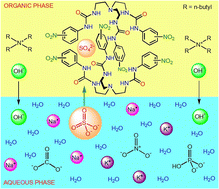Anion-exchange facilitated selective extraction of sulfate and phosphate by overcoming the Hofmeister bias†
Abstract
Selective recognition and removal of sulfate and phosphates from aqueous media in the presence of highly competing anions is very demanding because of their biological and environmental implications. In this paper, we present the anion recognition approach for the selective and efficient extraction of sulfate by nitrophenyl-functionalized tris-urea receptors (L1–L2) from highly competitive aqueous media with an equivalent concentration of nitrate and other anions. Tetrabutylammonium hydroxide has been used for the first time as a phase transfer anionic extractant for sulfate-exchange from the aqueous phase to the organic phase (dichloromethane) containing a tris-urea receptor (L1–L3). The sulfate extraction efficacy of L2 (≈84–90%) was observed to be higher than those of L1 (≈76–82%) and L3 (≈68–75%) in competitive extraction experiments. In contrast, an analogous nitrophenyl-functionalized tris-thiourea receptor (L4) has been recognized for the selective and efficient extraction of phosphates from aqueous media in the presence of several competing anions including sulfate and nitrate, with ≈85–92% extraction efficiency. In this case, tetrabutylammonium acetate has been used as a phase transfer anionic extractant for phosphate exchange between the two immiscible phases. Due to the higher acidity of tris-thiourea –NH groups in comparison to the analogous tris-urea, tetrabutylammonium hydroxide could deprotonate a hydrogen bond donating –NH group of the thiourea receptor and phosphate extraction was observed to be inefficient in such a case. Several liquid–liquid extraction (LLE) experiments have been carried out to establish the selective removal of sulfate and phosphates by the tripodal receptors from competitive aqueous media having different combinations of two or more anions. The LLE products obtained from organic phases were characterized by NMR (1H, 13C, 31P, and 19F) spectroscopy to affirm the oxoanion selectivity of the receptors and purity of the complexes. The tripodal receptors can easily be recycled for successive extraction cycles by simply washing the LLE products (oxoanion complexes) with a methanol–water (1 : 1, v/v) solvent system followed by filtration.



 Please wait while we load your content...
Please wait while we load your content...